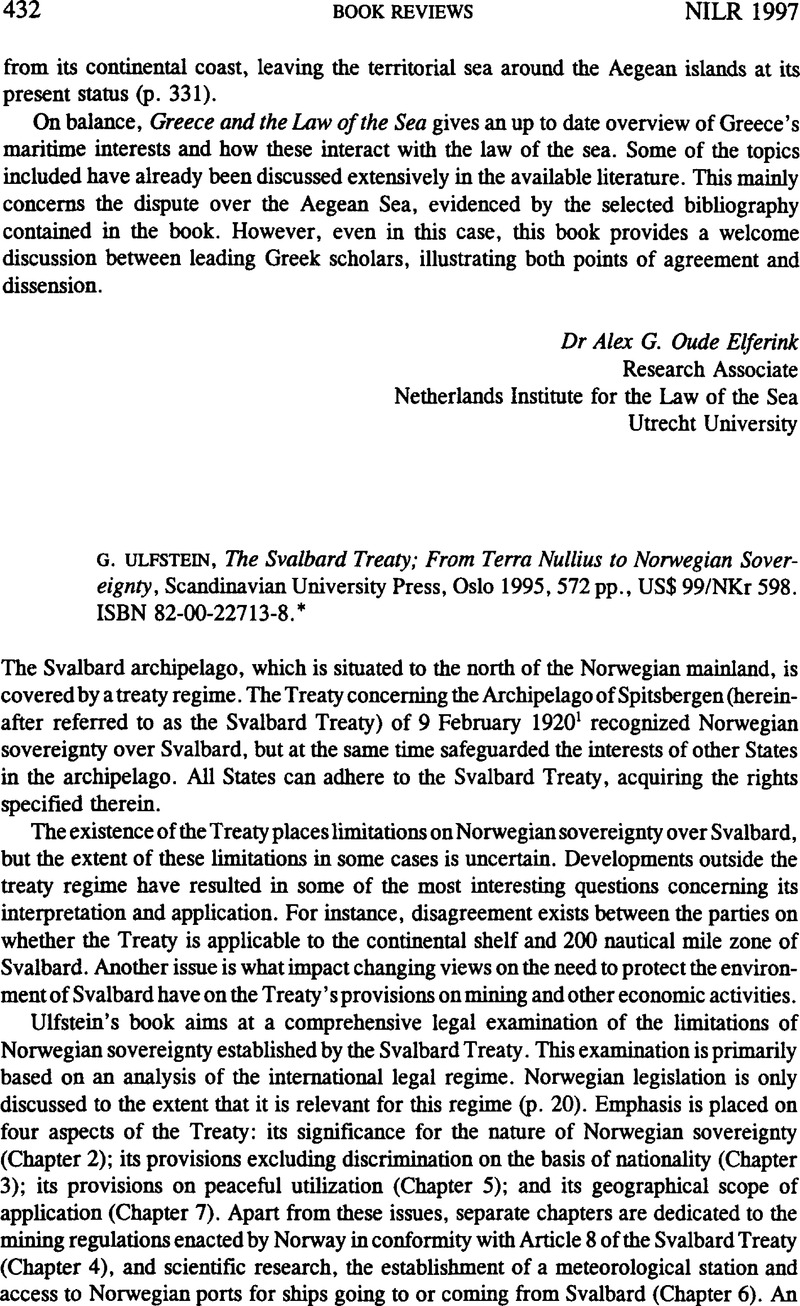No CrossRef data available.
Article contents
G. Ulfstein, The Svalbard Treaty; From Terra Nullius to Norwegian Sovereignty, Scandinavian University Press, Oslo1995, 572 pp., US$ 99/NKr 598. ISBN 82-00-22713-8.
Published online by Cambridge University Press: 21 May 2009
Abstract

- Type
- Book Reviews
- Information
- Copyright
- Copyright © T.M.C. Asser Press 1997
References
* The reviewer wishes to thank Dr Harry Post and Dr Erik Molenaar for their comments on an earlier draft of this review.
1. 2 LNTS (1920) No. 1, pp. 7–19.Google Scholar
2. This assessment seems to be confirmed by a recent judgment of the Norwegian Supreme Court involving the non-discrimination provisions of the Svalbard Treaty (Judgment of 7 May 1996, Public Prosecutor v. Haraldsson et al.; see further Churchill, R.R., ‘Norway; Supreme Court Judgment on Law of the Sea Issues’, 11 Int. J Marine & Coastal L (1996) pp. 576–580, at pp. 577–578).Google Scholar
3. Cf., Bimie, P.W. and Boyle, A.E., International Law and the Environment (1992) pp. 122–123.Google Scholar
4. In the Guinea-Bissau/Senegal arbitration a delimitation line of the continental shelf was considered not to have delimited the 200-mile zones of the parties, as this zone at the time the delimitation treaty was concluded did not exist (Arbitration between Guinea-Bissau and Senegal concerning the Delimitation of the Maritime Boundary, Decision of 31 July 1989 (94 RGDI (1990) p. 204, at para. 85)). In the Guinea/Guinea-Bissau Maritime Delimitation arbitration the Arbitral Tribunal rejected that a treaty line from 1886 defining sovereignty over islands had a legal relevance for the determination of a maritime boundary (Guinea/Guinea-Bissau Maritime Delimitation arbitration, Decision of 14 February 1985 (International Boundary Cases: The Continental Shelf (1992) Vol. II, p. 1301, at p. 1338, para. 84)). Finally, in the Gulf of Maine case the International Court of Justice doubted that Art. 6 of the Convention on the Continental Shelf could provide the legal basis to draw a single delimitation line for the continental shelf and the superjacent fishery zone (Case concerning Delimitation of the Maritime Boundary in the Gulf of Maine Area (Canada/ United States of America), Judgment of 12 October 1984 (ICJ Rep. (1984) p. 246, at p. 301, para. 119)).Google Scholar
5. In the case before the Norwegian Supreme Court cited supra n. 2, the Court decided that it did not need to resolve the issue of the applicability of the Svalbard Treaty to the 200-mile zone. However, it took the view that even if the Treaty did apply, Norway's measures had not breached its non-discrimination provisions (Churchill, loc. cit. n. 2, p. 577).


